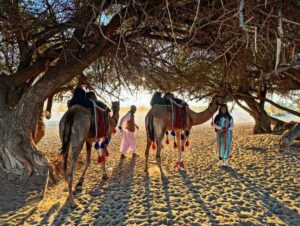Rosie Stancer and Pom Oliver have successfully crossed the Aralkum desert by foot. Their unique 600km expedition over the former sea bed of the dried-up Aral Sea ended successfully on September 6, after 17 days.
Their initial plan had been to haul their specially designed carts all the way. But after a week amid thorny desert shrubs — perhaps the camel prickle endemic to Central Asian deserts — “the wheels took a real hammering and we got multiple punctures,” Stancer told ExplorersWeb.
Eventually, they had to send the carts back to the town of Aral for a wheel change.

Rosie Stancer and Pom Oliver become the first to trek across the Aralkum desert. Photo: RosieStancerExploration/Facebook
At the same time, Oliver had become quite ill, so she returned to Aral for about 10 days with the carts. During that time, Stancer “had to go it alone with a horribly heavy rucksack.”
From cart to backpack
The main reason that her backpack weighed so much was the amount of water that she had to carry. When they initially set out, their carts weighed 100kg each, because of their water needs. They planned to resupply with water occasionally, but carrying everything in a pack meant that Stancer needed a source of water every third day.
Logistically, this was difficult. “I had to very carefully work out my time and distance,” she said. “I just had to walk the length that was required to meet the target drop-off points. The idea of being stranded somewhere without water is very stressful.”

Photo: RosieStancerExploration/Facebook
Once, as Stancer was walking, “it looked like a dust storm was rolling in.” The dust storms in the area are ferocious.
“The moment you get an inkling, you start planning,” she said. “You keep walking but your mind is whirring. You’re thinking right, this is what I’m going to do. I’m going to have to make camp extra securely before the wind gets up and the storm hits, and secure the tent with sandbags.”
Luckily, the wind changed, and the dust storm dissipated. But weather continually challenged them during their three-week expedition. Temperatures soared above 50˚C, which caused their tongues to swell so much that it was almost impossible to eat.
“You could only drink and you had an unquenchable thirst,” said Stancer. “We had to ration the water because of the weight.”
Anthrax Island
Since the Aralkum Desert used to be the Aral Sea, any water they did come across was salty. It was also toxic. Nearby Vozrozhedenyia Island was an old testing ground for biological weapons. Often, they passed the carcasses of camels, wild horses, and cattle that had died of thirst or other afflictions.

A ‘rubbish sorting stop’, Rosie and Pom carried all litter with them for the duration of the expedition. Photo: RosieStancerExploration/Facebook
The pair didn’t visit Vozrozhedenyia Island but they did take precautions in the region. Both wore masks and had to take antibiotics due to lingering strains of anthrax and possibly bubonic plague and smallpox, which Soviets had been experimenting with.
“It was around that leg of our journey that Pom was feeling very unwell, and I was feeling extremely sick too,” said Stancer.
In part, they did the trip to highlight the region’s destruction. They passed rusting ships and seashells, now hundreds of kilometres from water. But they also saw incredible beauty. “Some of the salt pans were so vast and shimmering they reminded me of a Shirley Bassey dress,” Stancer told ExplorersWeb. She also loved the beautiful desert starscapes.
Occasionally, they came across little villages. Previous fishing communities had to “carve out a life for themselves”, as the Aral Sea diminished.
Yet they felt that things might be improving a little. A new dam had opened up fresh waterways, and fish numbers have risen slightly in the Small Aral Sea.

Photo: RosieStancerExploration/Facebook
Treated royally
Local people were surprised by their endeavor, first, because they were women, and second, because they were on foot. At the same time, they were “incredibly kind, always offering us the little that they had,” said Stancer. One man seemed so alarmed to find Stancer walking by herself in the heat that he leaped out of his truck, arms laden with cold water and bread.
The scariest moments invariably happened at night. Some people she met “were not exactly sober”. One evening, when Stancer was alone, she “got a grilling through my tent flap by what seemed to be a government official.” The unexpected visit shook her.
Stancer’s family status may have helped her avoid too much bureaucratic obstruction. Local media coverage reported that she was the Queen’s sister. Not quite true: In fact, the two are cousins.
Logistically the trip was not easy, with COVID restrictions adding to the general prickliness of that ex-Soviet part of the world. To get into Kazakhstan, they needed special permission.
“We had to go right to the top and get letters from the government,” she said. They stayed in Kazakhstan because Uzbekistan would have been even less supportive.

Photo: RosieStancerExploration/Facebook
As a former polar traveler, Stancer didn’t take well to the extreme heat. Sickness and unexpected use of a backpack led to drastic weight loss. She weighed just 41kg by the end of the trip. Wearing a heavy backpack in the heat rubbed the skin off her back. Then her shirt meshed into the flesh.
“My body was completely wasted, and I don’t know how I was kept one foot in front of the other,” she said.
Now back in the UK, she is recovering quickly.

Photo: RosieStancerExploration/Facebook






